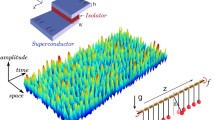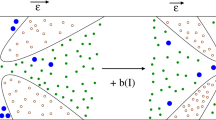Abstract
The standard two factor excitation theories should be called “preexcitation” theories since they apply only to those events occurring just up to excitation. A true phenomenological excitation theory which describes thewhole excitation cycle must involve non-linear equations. The nature of these non-linearities is suggested by B. Katz's subthreshold response data. From this data is constructed a “local phenomenological characteristic” which is analogous to the current-voltage characteristic of a non-linear electrical or mechanical system capable of displaying relaxation oscillations. Excitation by constant currents is shown to occur where the slope of the characteristic changes sign. The variation of the time constant of excitation with degree of response, explained by W. A. H. Rushton in terms of a liminal length, is described here in purely formal terms. The theory as presented explicity treats only those events in the excitation cycle up to and a little beyond excitation; the complete excitation cycle (including recovery and repetition) is mentioned as being amenable to mathematical treatment by an extension of the present theory.
Similar content being viewed by others
Literature
Arvanitaki, A. 1939. “Recherches sur le Réponse Oscillatoire Locale de l'Axone Géant Isole de Sepia.”Arch. Int. Physiol.,49, 209–256.
Blair, H. A., 1936. “The Kinetics of the Excitatory Process.”Cold Spring Harbor Symp.,4, 63–72.
Blinks, L. R. and R. K. Skow. 1940. “The Electrical Capacity of Valonia.”Jour. Gen. Physiol.,24, 247–261.
Cole, K. S. and H. J. Curtis. 1938. “Electric Impedance of Nitella During Activity.”Jour. Gen. Physiol.,22, 37–64.
Cole, K. S., and H. J. Curtis. 1941. “Membrane Potential of the Squid Giant Axon During Current Flow.”Jour. Gen. Physiol.,24, 551–563.
Cole, K. S., 1941. “Rectification and Inductance in the Squid Giant Axon.”Jour. Gen. Physiol.,25, 29–51.
le Corbellier, Ph. 1931.Les Systèmes Autoentretenus et les Oscillations de Relaxation. Paris: Hermann.
Herrenden-Harker, G. F. 1940. “Relaxation Oscillations.”Am. Jour. Physics.,8, 1–22.
Hodgkin, A. L., 1938. “Subthreshold Potentials in a Crustacean Nerve Fiber.”Proc. Roy. Soc. B.,126, 87–121.
Householder, A. S. 1939. “Studies in the Mathematical Theory of Excitation.”Bull. Math. Biophysics,1, 129–141.
Hill, A. V. 1936. “Excitation and Accommodation in Nerve.”Proc. Roy. Soc. B.,119, 305–355.
Katz, B., 1936. “Multiple Response to Constant Current in Frog's Medullated Nerve.”Jour. Physiol.,88, 239–255.
Katz, B., 1937. “Experimental Evidence for a Non-Conducted Response of Nerve to Subthreshold Stimulation.”Proc. Roy. Soc. B.,124, 244–276.
Katz, B. 1939.Electric Excitation in Nerve. London: Oxford University Press.
Monnier, A. 1934.L'excitation Électrique des Tissus. Paris: Hermann.
Monnier, A., and G. Coppée. 1939. “Nouvelles Recherches sur la Resonance des Tissus Excitables I. Relation entre la Rhythmicité de la Réponse Nerveuse et la Résonance.”Arch. Int. Physiol.,48, 129–179.
Pumphrey, R. J., O. H. Schmitt, and J. Z. Young. 1940. “Correlation of Local Excitability with Local Physiological Response in the Giant Axon of the Squid (Loligo).”Jour. Physiol.,98, 47–72.
Rosenberg, H., 1937. “Electrotonus and Excitation in Nerve.”Proc. Roy. Soc. B.,124, 308–336.
Rashevsky, N. 1933. “Outline of a Physico-Mathematical Theory of Excitation and Inhibition.”Protoplasma,20, 42–56.
Rushton, W. A. H., 1932. “A New Observation in the Excitation of Nerve and Muscle.”Jour. Physiol.,75, 16–17.
Rushton, W. A. H., 1937. “Initiation of the Propagated Disturbance.”Proc. Roy. Soc. B.,124, 210–243.
Schaefer, H., 1940.Elektrophysiologie. Vienna: F. Deuticke.
Young, G., 1941. “On Reinforcement and Interference Between Stimuli.”Bull. Math. Biophysics,3, 5–12.
Author information
Authors and Affiliations
Rights and permissions
About this article
Cite this article
Weinberg, A.M. Non-linear excitation theory: Non-accommodative, sub-threshold effects. Bulletin of Mathematical Biophysics 4, 33–44 (1942). https://doi.org/10.1007/BF02477353
Issue Date:
DOI: https://doi.org/10.1007/BF02477353




